




•
EDITORIAL
EDITOR IN CHIEF
Kat Leon
MANAGING
Tasha Sayre
NEWS EDITOR
Zoë Buhrmaster
CO-NEWS
Alyssa Anderson
ARTS & CULTURE
Macie Harreld
SCIENCE &
Anish Kumar Arumugam
OPINION
Cameron Rodriguez
MULTIMEDIA
Sergio Cervantes
SOCIAL MEDIA EDITOR
Josi Struck
ONLINE AND PROMOTIONS EDITOR
Alley Henrici
DISTRIBUTION MANAGER
Aishwarya Suresh
COPY CHIEF
Isabel Zerr
CONTRIBUTORS
Alberto Alonso Pujazon Bogani
Amber Finnegan
Darcy Williams
Diana DeGroot
Isaiah Burns
Jessica Pelton
JJ Christensen
Lilli Rudine
Milo Loza
Thuyu Gedi
Vaishnavi Srinath
PRODUCTION & DESIGN
CREATIVE DIRECTOR
Briana Cieri
DESIGNERS
Arianna Thomas
Haley Hsu
Abby Raymundo Tomas
Parker Patnode
TECHNOLOGY & WEBSITE TECHNOLOGY ASSISTANTS
George Olson
Hongzu Pan
Sara Ray
ADVISING & ACCOUNTING
COORDINATOR OF STUDENT MEDIA
Reaz Mahmood
SALP ACCOUNTANT
Maria Dominguez
STUDENT MEDIA TECHNOLOGY ADVISOR
Rae Fickle
To contact Portland State Vanguard, email editor@psuvanguard.com
MISSION STATEMENT
Vanguard’s mission is to serve the Portland State community with timely, accurate, comprehensive and critical content while upholding high journalistic standards. In the process, we aim to enrich our staff with quality, hands-on journalism education and a number of skills highly valued in today’s job market.
ABOUT
Vanguard, established in 1946, is published weekly as an independent student newspaper governed by the PSU Student Media Board. Views and editorial content expressed herein are those of the staff, contributors and readers and do not necessarily represent the PSU student body, faculty, staff or administration. Find us online 24/7 at psuvanguard.com.
WRITE: News, Arts & Culture, Science & Tech, Sports and Opinion
PHOTO & FILM: Create engaging content that captivates our audience in modern and creative ways
EDIT: Ensure precision, clarity and consistency in every article
DESIGN: Create impactful visual content that empowers, respects, educates, guides and shares truth
Learn skills, build a professional portfolio and make your own schedule. We are willing to train inexperienced applicants who demonstrate ability and a desire to learn the skills. Contributors are paid for published work.

DOUG WEISKOPF, PSU ‘71 ALUM
Dear editor:
As a 1971 [Portland State] alum who was involved in organizing peaceful campus protests against the Vietnam War and was attacked and injured by the Portland police on May 11, 1970 in the [South] Park Blocks, I would like to ask current PSU students to please remain nonviolent and respectful towards others who may not share your views. The level of student vs student rage on many American campuses today have become dangerous and will have long-lasting negative consequences.
[In a] Kent State University Archives phone interview I participated in on [Jan. 18, 2023], I spoke about how the 13 students who were shot by the Ohio National Guard, with 4 students dead, is an example of what can happen when protests become out of control and the authorities over-react. I hope what can be learned from this discussion of the tragic events of 54 years ago might be a useful lesson for today’s protesters.

As the 2024 Associated Students of Portland State University (ASPSU) elections inch closer to voting time, three candidate duos remain in the presidential and vice presidential race.
The president and vice president candidates are as follows, respectively, per ticket: Brady Roland and Ulfet Tayba on ticket PSU4YOU; Jordan Jay and Angelika Vinevsteva, who represent Voices of Action; and Nolan Bylenga and Dave Hartless, whose ticket Bylenga/Hartless reflects their last names.
On May 3, voting will open for the 2024 ASPSU elections. Students can elect candidates to the highest-ranking positions in the student government: the senate, the Student Fee Committee (SFC), the Judicial Review Board and the Executive Cabinet.
The annual election brings with it questions. What does the student body president do for campus anyway? What about the vice president? How do they conduct their business and in what ways do they represent the student body?
According to Roland—current ASPSU Senator and PSU4YOU presidential candidate—the answer to those questions aren’t so simple.
“I would say the student body president has so many roles, and every year it changes with the new administration,” Roland said. “Different people operate differently. I would say the biggest role the president has is making sure that [the] student government is working effectively and collaboratively to get work done.”
Three weeks ago, Roland announced that she was running for president, a spontaneous decision that came after the current incumbent, Yousif Ibrahim, dropped out of the race.
The president acts as the primary figurehead for ASPSU and is the leading student-body representative in all school affairs, according to orientation slides ASPSU provides incoming presidents and vice presidents. They are responsible for managing the Executive Cabinet—a team that aims to coordinate everyday operations of ASPSU—and the Leadership Team, a core team of members which includes the president, vice president, senate speaker and campus and operations coordinators. In addition, the president acts as the ASPSU program coordinator, a position that involves communicating and coordinating with offices such as the SFC.
The vice president shares similar responsibilities in that they must assist the president in managing both the Leadership Team and the Executive Cabinet.
Vice President Tayba—who’s running for her second term as the PSU4YOU vice presidential candidate—explained how she felt unready to leave the position.
“Honestly, I feel like the main reason was just that I felt like I had too much unfinished business,” Tayba said.
She referenced intra-ASPSU communication as an item she would focus on if re-elected.
“I found that when I joined, there was just a little bit of a disconnect between different committees, where people wouldn’t be aware of what another group is working on,” Tayba said.
“So we’ve kind of been working on sharing more during our senate meetings and keeping everyone in the loop as to the projects we’re working on,” Tayba said. “It makes you more efficient and cohesive as a group, especially because a lot of the time you’ll get different perspectives from other people.”
Voices of Action presidential candidate Jay said this is not exclusively a problem within student government, but a broader trend which can be seen campus-wide with shared resources.
“I do believe that there are a lot of incredible resources available on campus and in the Portland community,” Jay said. “The big gap is connecting students with those resources.”
Jay cited one example in which he recently discovered that the Basic Needs Hub offered a range of services he was unfamiliar with, including support for rent and utilities for students with electronic benefit transfers, or EBT.
“If I didn’t know about that and I’m already in the community of equity, then there really is a big gap in communication with students,” Jay said. “That’s something we plan to improve.”
Jay’s running mate, Vinevsteva, wants to make ASPSU a more responsive institution and an organization that holds the administration and the board of trustees accountable on behalf of the student body.
“A recent example was that students wanted to cut ties with Boeing,” Vinevsteva said. “Another example was housing rates, housing accessibility and how hard it is at the dormitories. Pretty much every single issue that arises on campus should be communicated, and the Board of Trustees should know the student government face-to-face.”
Bylenga and Hartless highlighted seeing increased activity among students in general when it comes to student government. Bylenga had previously served as a senator before the pandemic. When the school closed on-campus operations due to COVID-19, Bylenga had been working on a project with ASPSU to provide space for students to debate political issues, increasing student engagement.
“We were reaching out to local politicians, even the Governor’s office at one point,” Bylenga said. “Then, right in the middle of setting that up, they canceled all the in-person school. The hope for me [if elected] is to be able to bring back that kind of sentiment and re-engage people to build social media and other things.”
Hartless said he wishes to see more encouragement and increased access to voting in the student body.
“One thing I would like to see change is the ASPSU rules for registering students to vote,” Hartless said. “I think that’s a huge thing—that we’re a liberal arts college, yet we don’t promote people registering to vote. I’m a big fan of democracy, and I think that should be the biggest thing for everything, because that shows us being active inside the campus [and] showing students that we care about your voice. We want your voice to be heard, and let’s help you get there.”
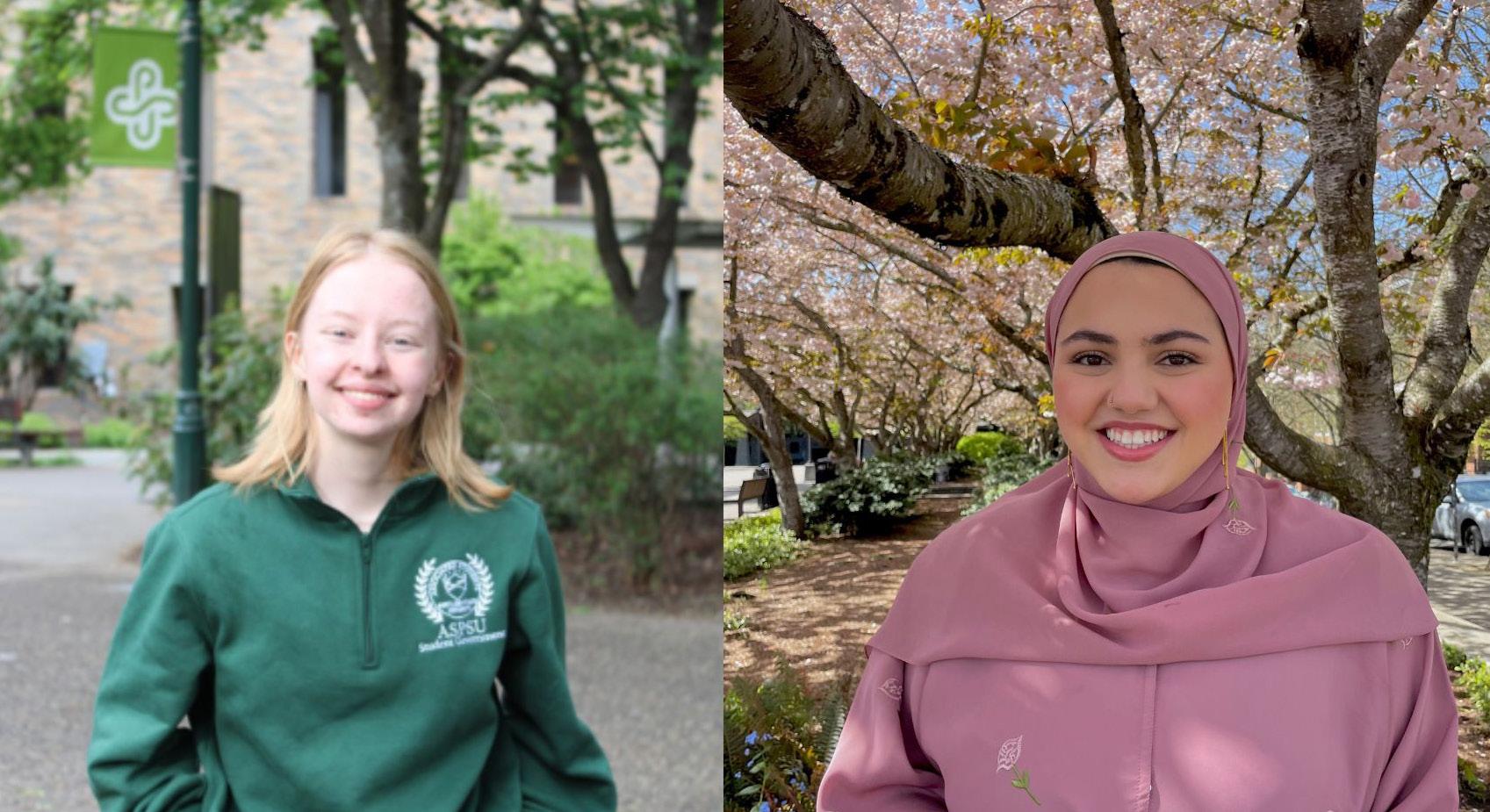


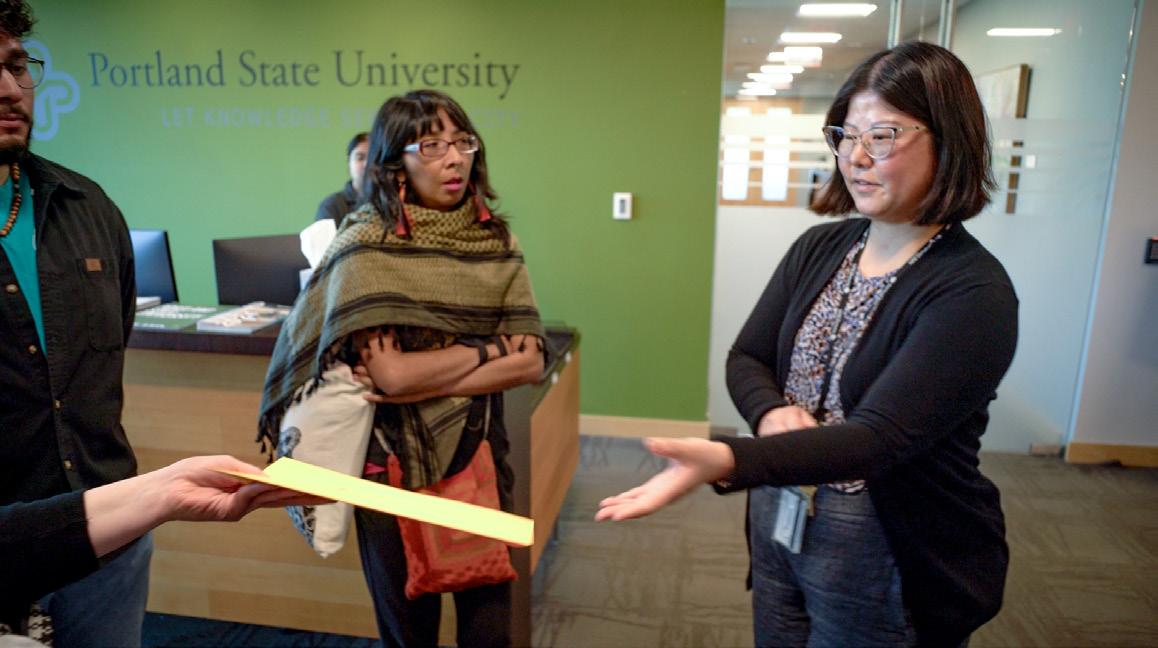
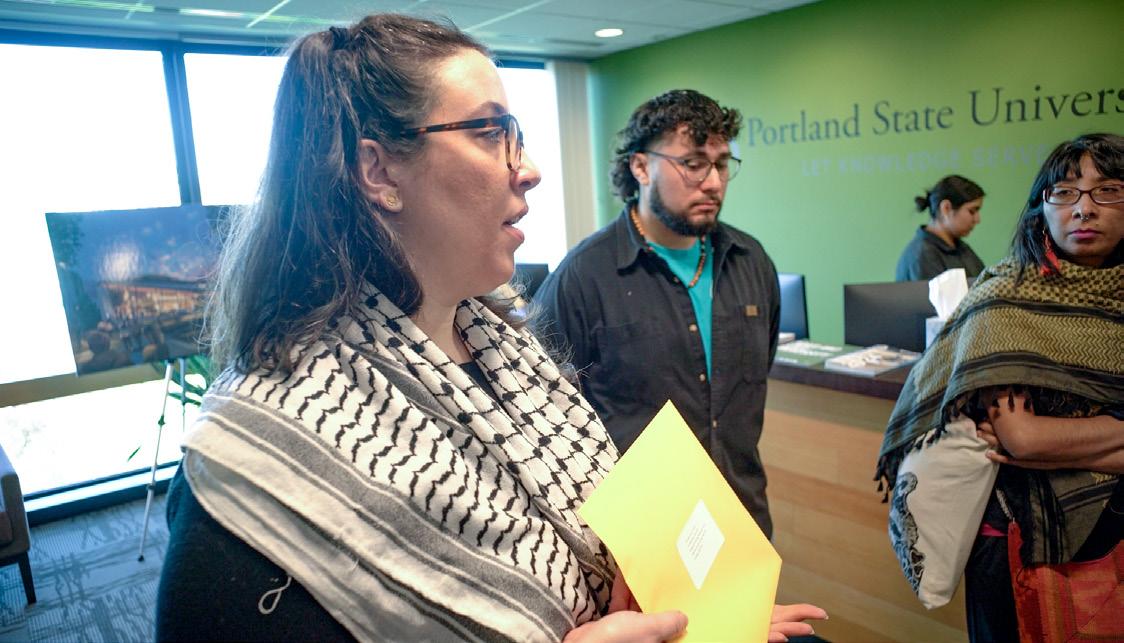
In response to a letter from activists and faculty criticizing Cudd's handling of calls to sever ties with Boeing, Cudd agreed to temporarily halt seeking or accepting any additional gifts or grants from Boeing. She intends to create a space for debate and dialogue on the matter before deciding further action
ALYSSA ANDERSON
A group of Portland State students and faculty, alongside members of Democratic Socialists of America and Jewish Voice for Peace, hand-delivered a letter signed by over 1,300 students, faculty and community members to the office of President Ann Cudd in the Richard & Maurine Neuberger Center on April 22.
Though Cudd was not present in her office when the group delivered the letter, they were met by her executive assistant, and those present made statements captured on video by KBOO radio’s public affairs program “Old Mole Variety Hour.”
In PSU Student Media’s March press conference, Cudd said the demands for PSU to cut ties with Boeing were arbitrary and she saw “no logical reason to cut ties with Boeing.”
In an email sent out to PSU students and faculty on April 26, Cudd responded to the community letter and said it—along with the continued passionate demands by the PSU community—has motivated her to reexamine PSU’s relationship with Boeing and ask additional questions.
The email explained PSU will host a forum in May where these concerns can be formally debated. During this two-hour moderated debate, which will include faculty and student voices, Cudd said she would participate by representing the perspective of academic ethics.
“I want to share my thoughts on the matter and model the civil discourse and spirit of open inquiry that should guide any great university,” Cudd stated.
Cudd stated that until PSU can agree on a reasonable course of action to proceed with this relationship, the administration will pause seeking or receiving additional funding from Boeing.
Along with reexamining the university’s ties to Boeing, the community letter had requested Cudd “rescind the retaliatory measures taken against students over their peaceful protest at the Board of Trustees meeting on Jan. 26, and to cease any further investigation of students or faculty. The group Students United for Palestinian Equal Rights (SUPER) has been placed on probation as a consequence of the Jan. 26 protest, and other disciplinary actions and investigations are ongoing.”
Cudd’s response explained she had heard the concerns surround-
ing the treatment of those engaged in protests on campus. According to Cudd, nobody involved in a protest has been sanctioned for the contents of their message.
“PSU has always been and will remain a place where free speech and academic freedom are treasured,” Cudd’s email stated. “Our focus is on drawing a bright line between protecting freedom of speech and activities including discrimination, harassment, intimidation, property damage, and assault. We have reasonable time, place and manner restrictions in place — these are community standards so that our university can continue to be a place for learning, teaching, working and living” [emphasis in original].
Alexis Lisandro Guizar-Diaz—a Chicano doctoral student in environmental sociology, McNair scholar and interim President of the Graduate Employees Union of PSU—is currently facing an investigation by the university for being present at the Jan. 26 protest. Guizar-Diaz said that, as a public institution, PSU’s responsibility is to serve the people, and he called the relationship with Boeing disheartening and something which must be confronted, as students and community members have been demanding it for years.
Yasmeen Hanoosh—an Iraqi-born professor of Arabic at PSU—is also under investigation for her presence at the protest. She feels like the university has not protected her First Amendment rights. “My own department was instructed to silence me when I began speaking against the mass killing and ethnic cleansing of Palestinians in Gaza in October by suddenly instating university policies around the use of departmental listservs that prohibit discussion of ‘political content,’” Hanoosh said. “I am therefore heartened to see our PSU community and larger Portland community rise up in protest against PSU’s attempts to violate our academic freedom and First Amendment rights, and to call into question the egregious discrepancy between administrators’ words and deeds.” Cudd said the university will continue to enforce these policies evenly for all campus events—including protests—and they expect community members to conduct themselves accordingly.
MILO LOZA
Pairings Portland: Reserve a table for two
Pairings Portland Wine Shop
May 6, 4 p.m.
$30
An intimate dinner with curated wine pairings
In
MISSING LOCATION
May 7, 4:45 p.m.
$9
A visually stunning film exploring love and longing in 1960s Hong Kong
Holocene, Portland
May 8, 8 p.m.
$20
Pop duo performance with vibrant and lively vibrations
Gigantic Brewing Company
May 9, 7:30 p.m.
Free
A live stand up comedy show featuring local comedians
Pearl Jam at Moda Center
Moda Center, Portland
May 10, 8 p.m.
From $367
Legendary rock band on their new tour, Dark Matter
Haters Comedy Roast Battle
Funhouse Lounge, Portland
May 11, 10 p.m.
$15
Local comedians in a sharp-tongued roast battle
Her
OMSI
May 12, 4 p.m.
$8
A poignant film about a lonely man who develops a deep relationship with his AI system

In a world where menstruation is often stigmatized, a groundbreaking shift is happening. Thanks to innovative research and technology, the once-dismissed menstrual blood is emerging as a source of valuable insight into the health of menstruators.
The things that come to mind when one considers getting tested for a disease are probably blood draws, urine tests and nasal swabs. Period blood doesn’t spring to mind even though two billion people worldwide menstruate.
The United States Food and Drug Administration approved a health test utilizing period blood for the first time earlier this year. The diabetes biomarker detection at-home test provides an alternative to the blood draws which are conventionally necessary for diagnosing the condition.
“One of the biggest hurdles in embracing period blood testing is overcoming deeply ingrained misconceptions,” said Søren Therkelsen, co-founder of Qvin. He emphasized the need to dismantle the stigma surrounding menstruation. He challenges the notion that menstrual blood is gross or unnatural, asserting that it holds valuable health information just like any other bodily fluid.
The Q-Pad test kit from Qvin has two special menstrual pads with removable collection strips. After being collected during one menstrual cycle, both strips are mailed to a certified laboratory for testing. Results arrive via app or email.
The Q-Pad measures the average blood sugar over three months by testing the A1c biomarker for people with diabetes.
“On average, a [person with periods] menstruates for about 40 years, which gives about 400 times where you can collect menstrual blood for health testing,” Therkelsen said.
Additionally, Therkelsen discussed the potential for detecting sexually transmitted diseases, offering a private and anonymous solution for young individuals.
Amy Whitbread—chief scientific officer at the company theblood in Germany—highlighted the transformative potential of menstrual blood analysis. Through their Cycle-Check kit, individuals gain unprecedented insights into their menstrual cycles, empowering them to better understand and manage their health.
The Cycle-Check looks at the physical characteristics of menstrual blood alongside information on the menstrual cycle and its symptoms. It then provides information on what these can all mean in terms of health and offers some knowledge on how to help manage symptoms.
Researchers are also developing and validating a menstrual blood test to analyze biomarker levels like C-reactive protein and reproductive hormones. This test will provide personalized health data and guide users towards optimized diet, exercise and lifestyle choices.
Beyond dispelling myths, testing period blood has tangible implications for early diagnosis and treatment. Whitbread highlights research showing unique proteins in menstrual blood that could unlock insights into reproductive disorders such as endometriosis and ovarian cancer.
“This is what we and other companies that are working with menstrual blood are trying to prove: that it is actually a beneficial biological fluid and like liquid gold,” Whitbread said. “It is basically an untapped resource. And it’s exciting, because we don’t know that much about it at all, and we are just at the first stages of learning about its potential, and it’s already proving to be something extraordinary.”

A study by Heyi Yang et al. showed that there are 385 proteins that are unique to menstrual blood. “These proteins are not found in a typical blood draw or vaginal fluid, and we have no idea what most of them do,” Whitbread said. “These could be the key to early diagnosis of certain reproductive disorders, like endometriosis and ovarian cancer, which usually requires a physical exam, MRI or an invasive procedure, like a biopsy or even surgery.”
Another study by Sara Naseri compared samples of menstrual blood with blood circulating through the body from 20 menstruators over two months. The team concluded that menstrual blood could reliably estimate levels of several biomarkers, including diabetes, inflammation and reproductive hormones, and could be an alternative source for diagnosis and health-monitoring. In addition to testing menstrual blood for the diagnosis of diabetes, Naseri et al. have investigated the possibility of detecting human papillomavirus strains which significantly increase the risk of cervical cancer in the blood.
According to the World Health Organization, diabetes is responsible for over 100,000 fatalities in the U.S. and approximately 1.5 million worldwide annually. Diabetes-related complications encompass a range of adverse effects, such as those affecting the eyes, kidneys, nervous system and heart. Preventing these complications and ensuring timely treatment are all achievable by these tests.
Period blood analysis can offer valuable insight into health
Physicians have utilized blood tests to evaluate the health of their patients for nearly three-quarters of a century. Presently, the blood contains hundreds of biomarkers that provide insight into our health, ranging from nutrient deficiencies to cancer indicators.
Menstrual effluent—which consists of discarded cells and tissue from the thickened endometrial lining of the uterus during each cycle—is considerably more complex than arterial or venous blood. It contains blood obtained from other anatomical sites via blood draw, but it also contains uterine-specific proteins, hormones and bacteria.
For students intrigued by this burgeoning field, the opportunities are boundless. Whitbread encourages aspiring researchers to get involved, emphasizing the growing demand for expertise in menstrual health. With menstrual blood analysis poised to revolutionize healthcare, students can shape the future of menstrual health research.
It’s important to challenge old ideas and see the transformative potential of menstrual health research as we enter the unexplored frontier of period blood testing. Utilizing the potency of menstrual blood could completely change how we think about and meet health needs. Let’s use this time to give people more power, break down barriers and make the future healthier and more open to everyone.


Yes, it’s reached 70°F in Portland, so, naturally, the summer clothes have been uncloseted. The pitch on the previously rain-swept streets has jumped an octave. Buckets of rain are traded for buckets of flowers, three for $1. Winter traded for spring, from Andrew Wyeth’s barren trees to William Morris’ floral furor. Girls, like city nymphs, are draped in Pre-Raphaelite colors and fabrics with indie-band logos on threadbare t-shirts, now unveiled from the thick drapes of vintage trench coat lapels. The South Park Blocks have never been more of a tripping hazard on this sunny Saturday afternoon at the Portland Farmers Market at Portland State.
Even the dogs have removed their Fair Isle sweaters in favor of a more natural look. A border collie embraces their effortlessly chic hair with a minimalist leash and collar—how particularly French.
It’s a beautiful day. God doesn’t even have to break through the clouds to make his golden presence known. Without a single hint of impending gloom in the sky and a sea of sunburnt shoulders, California is rightfully jealous.
It makes the usual Larry David disposition on the world a little more difficult to obtain. Not even that pathetic little sigh, sometimes for no reason in the cold solitary pursuit of intimacy, can be heard—at least, not from me. Just the slightly intimidating, all-powerful-yet-gentle godliness of spring.
Now nature, as I am very aware, has its enthusiasts, but on the whole I wouldn’t say I’m one of them. To me, the great outdoors
is simply the unforgiving portal through which you must trespass to get from the bus stop to your front door. That’s what’s wonderful about Portland; interwoven in a tight braid down the back of a twenty-first-century flower child are the city, forests and skateparks.
You watch the classical guitar player. Maybe they know you’re watching them, or maybe they’re unaware. Who are you kidding? Of course, they know you’re watching them. Suddenly, their eyes dart to yours, and you look away shamefully. You smell the freshly unearthed produce, lavender and smoked meat, but most of all you are despairingly thirsty. Unable to find reprieve, you question waiting 20 minutes in line for your customarily-overpriced beverage.
All the charms of the liberal United States—which, by the way, are unpolarized and unpasteurized—are on display. Moving slowly up and down the walkway, you clasp your hands behind your back as if you were in the Louvre.
Need to embody Anthony Bourdain’s cool elegance and spontaneity? Hit up the fungus stall to add a twist to tonight’s dinner. Need to win over a lover? Feed them the most perfect strawberry you’ve ever seen.
The human ear is naturally drawn to the sound of music. Follow it. Past the current of young parents who guide their children by the shoulders as if they were shopping carts, past the girl selling used books on the staircase, there is a chorus of voices singing songs for Palestine, holding signs and flags with
painted watermelons and doves.
I stood and listened with the other onlookers for a while. A mother and her young daughter leaned against each other on a bench opposite the singers. I overheard the mother explaining why they were singing and what it meant, all in terms a child would understand. It made a much stronger impression on me than anything else that day.
And the green—the green is everywhere: the tops of carrots, the covers of books, the cardigan tied around the waist of a busy vendor. Green is the color of spring and rebirth, the color of Oregon and the color of the shoes you wish you’d bought years ago at a thrift store.
But we tend to pull it out by its roots, scrubbing the world clean of it as fast as it grows. The wintertime may mute its vibrancy, but it always comes back with a vengeance. Portland doesn’t kill this green, though. Instead, we let moss and ivy grow along the sides of buildings and the spaces between cobblestones.
Like an inevitable colonizer of nature, you move off the pavement and into the grass, stepping over the dried mud and little white flowers that pepper the ground. You cross the rubicon of exposed roots and impromptu picnics to the other side of the street, finally quenching your thirst with a plastic cup of some holy nectar sold by a guy who looks just like David Foster Wallace. It costs too much money, and there’s too much ice, but the sun is out, children are laughing and the seller had such a kind face. And goddamn, it tastes, like, really good.


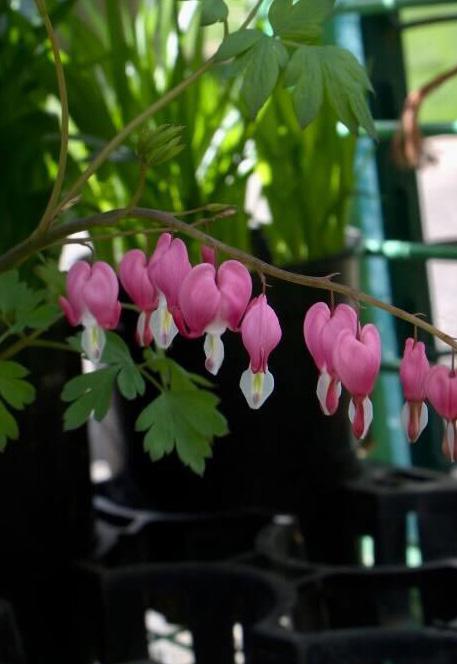
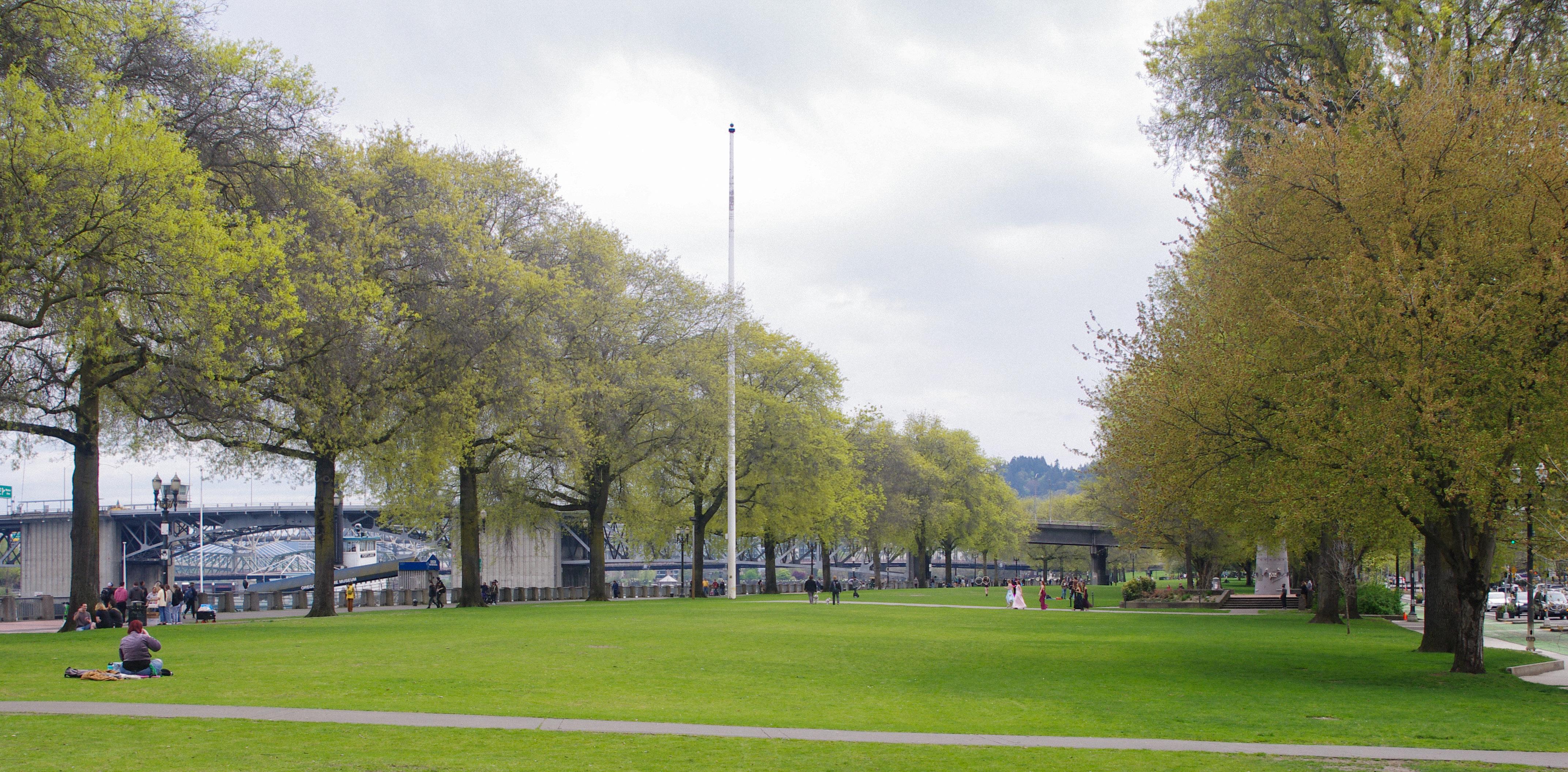
Spring is a joyous time in Portland. The world is waking up from a long winter—flowers are budding, birds are singing and the sun shines occasionally. Vernal beauty blooms all around us in the city. Nature’s most serene scenes can be calming if you’re feeling overwhelmed. Nothing beats the blossoming cherry and plum trees or watching the pink and white leaves falling, gusted by chilling winds. School can be tough, so take a break. Get yourself out there in the world and realign with your natural surroundings.
Downtown Portland offers some great outdoor opportunities to escape the slog of campus life. Below are three such examples.
LAN
Many places here incorporate the outdoors into the cityscape. One place in particular inspires lasting peace. Try visiting Old Chinatown at your next convenience. Ramble down the road until you chance crossing the Lan Su in Northwest Portland. If you do, then it must be a fateful day. Enter the gates and experience the magic.
Lan Su offers a tranquil setting. Here, you can forget about life’s compounding stressors. Every piddling worry flees like time. Inside the garden, nothing but the present moment matters. See the varied green, the jumping koi fish and the burgeoning springtime flowers. Meander down the cobbled path until you cross the bridge. Then close your eyes, and hear water lap down the hewn stones.
Now open them, and soak in these sights all together. Stare out there at Lake Zither until you feel at peace.
Lan Su marries art and architecture as one. Each structure complements the humble views inside the garden. Only seven Chinese gardens exist in the United States, and Lan Su’s unique history makes it stand out.
In 2000, Portland cooperated with landscapers, artisans and architects from Suzhou, China. Workers lived here for nine months and had rock and stone imported from China.
The diverse plant life also originated from the surrounding region. Its unique botanical diversity pleases the eye. Extraordinary flowers grow here: rhododendrons, peonies, magnolias, camellias and osmanthus. Every part feels like a well-written line in the garden’s poem. Portland has created a genuine modern marvel.
The garden also hosts seasonal events and over 500 different botanical programs throughout the year. Touring with a guide can be fun and informative.
Viewing stone exhibits teaches visitors about gongshi. Learn about the scholar stone’s history through miniature landscapes. The Penjing exhibit discusses the art of landscaped trees. In February, the Lan Su Teahouse reopened during the Lunar New Year. 2024 marks the Year of the Dragon, symbolizing power and strength in Chinese culture. The Steep in Words exhibition runs until April 30, with Julia Gaskill of Slamlandia. Enjoy Chinese poetry while sipping tea. Local poets also have workshops teaching basic guidelines.
Lan Su merits a day trip. Expect a good time when you come. It’s a respite from busy, hair-splitting schoolwork. The MAX Blue and Red lines stop in Old Chinatown. Parking is also spread throughout the area.
On Saturday, Portland’s Waterfront lights up with activity. Take a short walk at the Waterfront Park. Look out at the vast Columbia River, backed by the urban skyline. Sit down on a bench and soak in the sublime. Right now, the cherry blossoms are sprouting in March and April. Going further takes you to a long field. Bring a book or a picnic basket. On another day, the park’s vibe changes with the Portland Saturday Market
The Saturday Market has been going on for the last 50 years. It’s the longest-running market in the United States. All kinds of things go on: bazaars, street concerts and art shows. The market takes up entire blocks. One whiff from the food carts tickles the nose. There, you can eat cuisine from all around the world.
Get an elephant ear pastry for dessert. Wend your way through the fair and take it all in. Community artists sell wares like jewelry, magnets and paintings. Consider getting your mother a gift before Mother’s Day next month. Over 250 businesses sell souvenirs here at the market. Score a present before Sunday, May 12.
College can be a trying time. The tense pace turns the brain into cheese. Remember that next time you’re busting your hump, spending days at a time inside. Go outside your routine this spring. A whole wide world exists out there—seize it for yourself, when you can. Go on a walk, take a hike or call a friend. Breathe in the fresh spring air and get outside.



Step right up to Portland’s most exciting culinary journey yet! While downtown may boast its fair share of culinary delights, sometimes you need to venture beyond the city’s bustling heart to uncover true culinary treasures.
These eateries have been thoroughly vetted and tasted by regular patrons who frequent these establishments, ensuring an authentic and memorable dining experience. With deep familiarity with Indian cuisine and cultural nuances, our reviewers guarantee that each restaurant not only serves up traditional flavors but also provides a welcoming ambiance for all diners to relish.
At Biryani Corner in Hillsboro, the aroma of spices beckons you to savor the signature Chicken 555 Biryani—a steaming hot concoction bursting with flavor and spice. Pair it with Tawa Fish Fry Vepudu, a rich and flavorful delicacy that promises to transport you to the coastal shores of India with every bite.
Apna Chat Bhavan in Beaverton invites you to indulge in the richness of the softest Goat Dum Biryani, meticulously prepared to perfection, ensuring each mouthful is a symphony of flavors.
Visit 185th & Indian in Beaverton for a taste of the Konaseema Kodi Pulao, hailed as the most preferred chicken biryani around Portland—a culinary masterpiece that embodies the essence of traditional Indian cuisine.
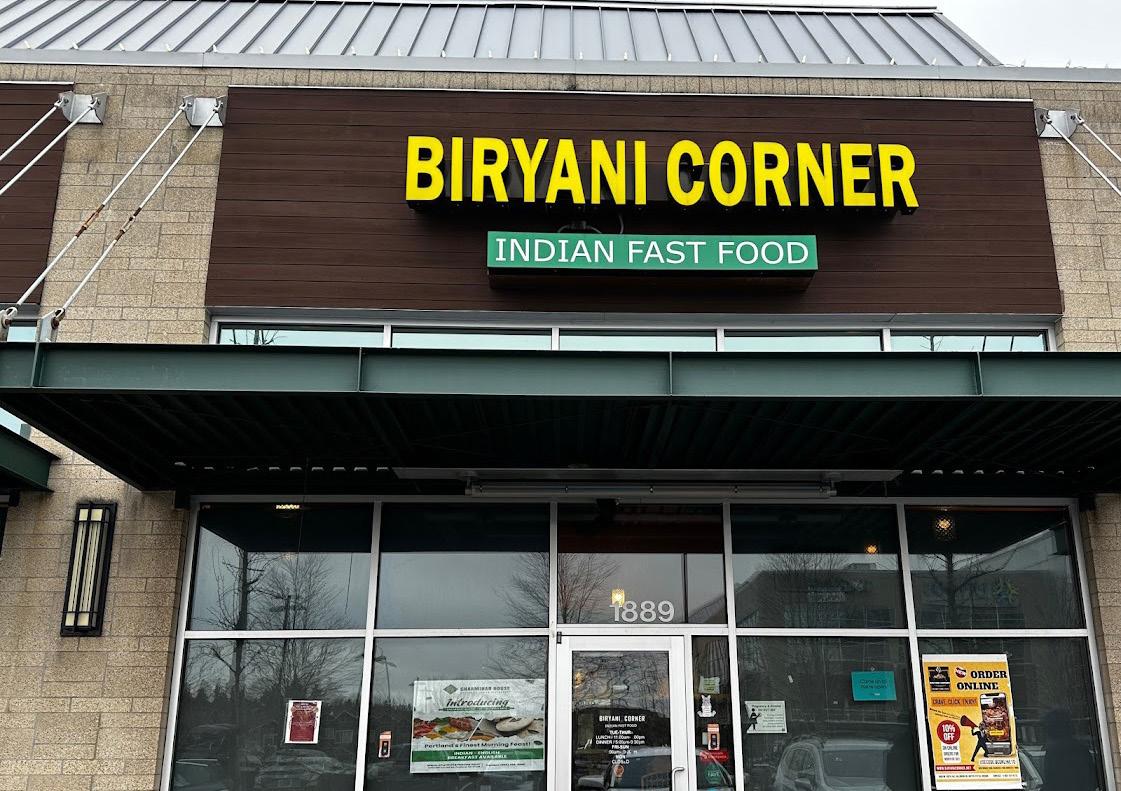










Craving something with a twist? Indian Flame Authentic Cuisine in Hillsboro has you covered with Chicken Fried Rice—a fusion of Indian and Chinese flavors served up street-style, guaranteed to satisfy your cravings. Also, don’t miss out on the sandwiches, offering both vegetarian and non-vegetarian options that are sure to please even the most discerning palate.
For vegetarian delights, look no further than India Sweets & Spices in Beaverton. Indulge in perfectly crispy Samosas—the quintessential Indian evening snack—or explore their array of chaat items, each bursting with flavors and textures.
Finally, wrap up your culinary adventure at Bombay Pizza & Curry in Beaverton where East meets West in a delightful fusion of flavors. Treat yourself to the Butter Chicken Pizza, a unique twist on the classic Italian dish with a generous topping of tender butter chicken. And don’t forget to try the Bombay Tandoor Wings—the epitome of spicy goodness.
40 minutes out of Portland lies the tallest waterfall in Oregon—Multnomah Falls. On April 14, 2023, three Portland State Vanguard editors and friends ventured out to hike to the top. While OregonHikers.org puts this trail as 2.4 miles, the way up consists of at least 11 steep switchbacks—an elevation gain of 870 ft. It’s probably best to skip the hike to the overlook if one is afraid of heights While on the trek, we took frequent breaks to allow every-
one to catch their breath. As we each monitored our own bodies, people decided to stop or called for more frequent breaks. While many people feel embarrassed to ask a group to stop, it allows us all to take a look at the nature around us. Life is the same. We aren’t in a race to the top, and we are allowed to enjoy the views and breathe.
I found taking photos was a great way to call for a pause. These photos were all taken either during a group-initiated pause



or my own personal one. I want to encourage us all—even on our walks through the streets of downtown—to take a closer look at our surroundings. You never know what you may find. If you’re interested in visiting Multnomah Falls or other sites along the Columbia River, check out the Columbia Area Transit. It operates most days and can take you out to Hood River, Dog Mountain, Cascade Locks and more depending on the time of year.











Once you see them, you can’t unsee themCAMERON RODRIGUEZ
Like mold in a house, once you notice it, you can’t ignore it. The feeling of seeing something which can cause problems—not only to the structure of your home, but also to the health of all the inhabitants—requires swift action to cull it, diminishing the possible harm.
But imagine mold spread in a home for years, covering the walls and furniture. Walking into this home, what would you feel?
The problem with mold is its obvious safety concerns and the lack of understanding of its spread. Identifying invasive species and dealing with them before they spread is the easiest way to limit the harm they can cause to an ecosystem and the spaces we share.
Invasive species are not just non-native species but also those which cause notable harm and pose a risk to native flora and fauna.
When hearing about invasive species, we might be prone to think of fauna such as bullfrogs, zebra mussels and quagga mussels. Even Oregon’s official list of invasive animal species is mainly aquatic.
Aquatic species often get more attention as they spread through the waterways, cause erosion and can affect more delicate ecosystems.
On a list of 11 species wreaking havoc in Oregon published by The Oregonian, 10 were aquatic and the other was feral swine.
Officials suggest reporting when and where you see these species at the Oregon Invasive Species Hotline or by calling 1-866-INVADER.
The ability to identify and recognize invasive species is important for reporting them.
While species such as feral swine might be obvious and recognizable, some of the most devastating and common invasive species which people see daily are plants. We are surrounded by harmful invasive plant species which can be identified if you know what they look like.
Plant awareness disparity (PAD), or plant blindness, is a real issue. It pertains to the loss of “attention, attitude, knowledge, and relative interest” people have towards plants. Plants—a large part of the ecosystem—often blend into the background for people who are unable to identify, differentiate or appreciate the role of plants in our world.
We have become disconnected from the environment we interact with every day, to the extent where people do not know better than to be enamored by the flowers and beauty of a noxious weed which disrupts the area it takes root in.
Invasive plants have a history not only rooted in the carelessness of people but also in the deliberate introduction of colonial plants and the eradication of native cultivated ecosystems. We can see examples of this with the black mustard plant in California. With beautiful blooms of fresh yellow, the noxious weed chokes out other native species.
Its history is intertwined with Spanish colonizers who would spread the seed as they spread missions along the Golden State, aka
California. Mustard sprouts around this time in the Willamette Valley, and you can see it along highways, cow pastures and open fields. Destructive to ecosystems, yet blooming all around.
People will admire how pretty these plants are without even seeing the harm, including erosion and creating ingestible zones of monocultures which have prevented any other plants from growing. Some of the more common and easiest invasive plants to identify for beginners are English ivy, Scotch broom and Himilayan blackberry.
English ivy (Hedera helix) trails up trees, buildings and hills, halting other species from being able to grow. The most harmful element of English ivy is its coverage with shallow roots and its parasitic relationship with trees it clings to, ultimately weakening and killing them.
For the Love of Trees offers comprehensive removal methods and different organizations to join if you want to volunteer to remove ivy vines. Often, this vine spreads with Himalayan blackberry across urban greenways along highways, train tracks and neglected urban spaces.
Himalayan blackberry (Rubus armeniacus) is known for its spread across the West Coast. It expands after dormancy in winter, creating large thickets of flammable bramble which create ecological hazards, especially as fire seasons increase in these regions.
There are additional species of blackberry, including evergreen blackberry (Rubus laciniatus)—a non-native species—and trailing blackberry (Rubus ursinus)—a native species. Understanding how to identify this species can help decrease its spread.
Due to its edible fruits’ spread and dormancy, this species can take over an area fairly quickly. Completely disposing of a blackberry bush can take lots of resources and time, especially if it is allowed to establish for long periods of time.
Scotch broom (Cytisus scoparius) is a bush found along highway corridors. It is known for its costly removal and its contribution to seasonal allergies.
Without knowing its harm, it’s easy to see the beautiful pop of golden as a beautiful shrub, but like the other species, it offers little to the habitat it takes over. If neglected, it can form a thick wall of dense shrub which degrades the land and creates fire hazards.
The easiest way to support native flora is to use your yard and green spaces as a refuge for native ecosystems. Since most college students do not have green spaces of their own, look for organizations and groups such as Portland State’s Indigenous Traditional Ecology & Cultural Knowledge (ITECK) or Friends of Tyron Creek
As people become more familiar with and interact with the outdoors, they should be aware that our place is to admire the pristine nature and preserve the natural systems which have worked for decades before colonization.

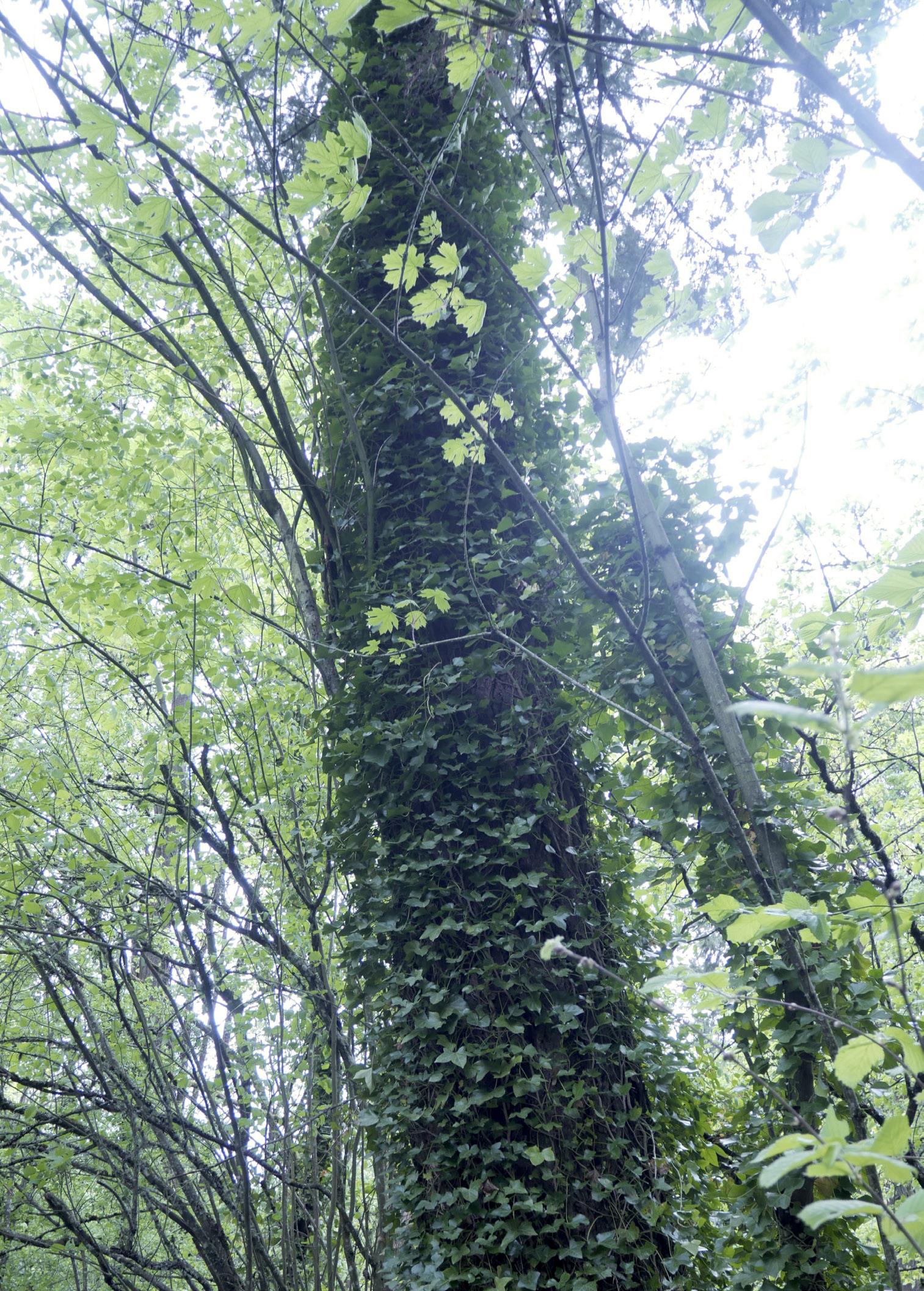

It was hot, like deep-in-the-depths-of-Hell hot. My weather app estimated the temperature to be 94°F, with a severe air quality warning.
And yet, I decided this was the perfect day to go on an uphill hike armed with only one dwindling bottle of water, a few slices of pineapple from Safeway, and a $2 joint I got on sale at my neighborhood dispensary. If I had used my critical thinking skills, I would have just stayed home and watched old episodes of Will & Grace as God herself intended. But, alas, there I was: comically ill-prepared and wheezing as I ventured onwards and upwards through the depths of Washington Park, my thirst growing stronger with each step. I had, regretfully, drunk most of my water on the train there.
The smoke was getting thicker the closer I got to the hill’s apex, yet I refused to turn back. In fact, it didn’t even cross my mind to turn around—at least not for a while. Perhaps it was pride, or perhaps it was the fact that I spent $1.25 of my discounted TriMet fare to get there, and I couldn’t bear letting my hard-earned money go to waste, but I refused to give up no matter how dizzy and disoriented I became.
This horrific journey of mine took place towards the end of last summer, when temperatures were reaching record-breaking highs most days of the week, and wildfire smoke clouded the skies more often than not.
A few weeks before this incident, I had awoken with a start only to find that I was suffering a pretty intense heat stroke—my skin beet red, breaths shallow, feeling as though my blood were boiling.
According to Google, I could have died that day. I spent the remainder of that day in the air-conditioned lobby of my building, staring into space and wondering if my brain had melted beyond repair.
It certainly felt like it.
You would think this experience would have inspired me to take more caution in the blazing summer heat, but no. Some people never truly learn from their mistakes. I like to think that my recently-boiled brain allowed my judgment to falter, resulting in the terrible ordeal I found myself in at the park. But I know I have no one but myself to blame for my foolish behavior.
Despite my ever-increasing panic, up and up I went, using all my energy to focus on the true-crime podcast I was listening to—one about murdered sex workers in Canada—that did nothing to quell my steadilyincreasing anxiety.
At some point, I stumbled, catching myself seconds before I would have plummeted into a deep, rock-filled ravine.
The park was empty, since everyone else in the Portland area had enough sense to stay home that day. I shuddered, thinking about how long it would have taken for someone to find me had I fallen, and only then did I decide to turn around.
Dreaming of the ice cream cone I decided to treat myself to once I reached civilization, I finally ventured back down the dreaded, smoky hillside. I told myself I would never tell a soul about this day, about how I nearly succumbed to smoke inhalation or heat exhaustion on a simple hike in a city park.
And yet, here I am writing about it for all to see. Perhaps that heat stroke did melt my brain after all, melting my sense of shame away forever.
That night, after gobbling down two-for-one ice cream cones from the corner store in my neighborhood, I took a cold shower and tucked myself into bed to watch several hours of Will & Grace with multiple fans pointed at me.
“This is where I belong,” I said to myself. “Going outside is overrated.”

Outdoor Altar Creation Workshop
Amber Jane Healing May 11, 1 p.m.
$45
Explore nature and spirituality through altar creation
Mother’s Day Market
Helvetia Farm Market, Hillsboro, OR
May 11, 10 a.m
Free
A vibrant market with food and activities
Painting in the Park
Chiming Fountain
May 12, 12 p.m.
$62
Enjoy painting outdoors with instruction for a relaxing Mother’s Day activity
Portland Outdoor Escape Game
Portland, OR
May 17, 12 p.m.
$10
A city exploration game merging history, puzzles and discovery
CityFair
Tom McCall Waterfront Park
May 24–June 9
$12+
As part of the Portland Rose Festival, a carnival will take over the waterfront for three weekends
Outdoor Meditation
Mt. Tabor Visitors Center
May 25, 2 p.m.
Free
Guided outdoor meditation session utilizing various techniques
Starlight Run
Tom McCall Waterfront Park June 1, 6:30 p.m.
$20+
The wacky warm up act for the CareOregon Starlight Parade
Autism spectrum disorder (ASD) is receiving more public attention these days. April marked Autism Acceptance Month, dedicated to celebrating the diverse experiences of individuals on the spectrum. While the month has passed, our journey of learning and understanding should persist throughout the year. It’s essential to reflect on our appreciation for those with autism, acknowledge the positive strides we’ve taken, and actively work to dispel harmful stereotypes and narratives.
It’s crucial to recognize the distinction between autism awareness and autism acceptance. Since 2011, numerous autistic communities and organizations—such as the Autistic Self Advocacy Network—have shifted their focus from mere awareness and the pursuit of a cure to promoting acceptance and embracing neurodiversity.
Historically, organizations in the autism community have often prioritized finding a cure for autism rather than promoting self-acceptance. Autism Speaks, one of the most prominent autism organizations, is known widely, but its reputation within the autistic community is mixed at best. Many autistic individuals perceive Autism Speaks as a hate group, viewing it as promoting a negative narrative that treats autism as something to be fixed or cured rather than embracing neurodiversity and supporting individuals with autism.
Some criticisms against Autism Speaks stem from their allocation of funds primarily towards advertising that supports Applied Behavior Analysis Therapy, which some liken to an autistic conversion camp. Additionally, they’ve been accused of emphasizing the challenges faced by parents of autistic children rather than focusing on the lived experiences and struggles of individuals with autism.
Cassandra Crosman, an autistic writer and activist, wrote about Autism Speaks’ history, highlighting instances of their involvement with organizations focused on finding a cure and promoting eugenics, as well as allegations of fund mismanagement and making upsetting and stigmatizing public service announcements (PSAs). Their PSAs have been criticized for perpetuating stigma and fear surrounding autism. For instance, the “I am Autism” PSA employs fear-mongering rhetoric, depicting autism as a rapidly spreading disease more formidable than pediatric acquired immune deficiency syndrome (AIDS), cancer and diabetes combined.
The use of disturbing music and threats from the personification of autism implies a need to rescue children from autism, portraying it as a predatory force to be shielded against. This is in stark contrast to how people with autism often advocate for identity-first language and see it as an inherent part of who they are, not as something they are afflicted with.
Autism Speaks also uses a puzzle piece motif from which many groups have moved away. The origins of the notorious puzzle piece originated with the National Autistic Society. “The puzzle piece is so effective because it tells us something about autism: our children are handicapped by a puzzling condition; this isolates them from normal human contact and therefore they do not ‘fit in,’” Helen Green Allison stated. “The sug-
gestion of a weeping child is a reminder that autistic people do indeed suffer from their handicap.”
While it’s crucial to raise awareness about the challenges associated with autism, the metaphor and imagery used in doing so often hurt the autistic community itself.

A study published by the journal National Autistic Society found that puzzle pieces generally invoked negative emotions. Later, the journal also changed its symbol. Various organizations have opted out of the puzzle piece to something more expansive and representative of autism. The current popular symbol of acceptance is the rainbow-colored infinity symbol, and sometimes the gold infinity symbol for autism, since “Au” is the symbol for gold on the periodic table. The infinity symbol emphasizes the experiences of autistic people as vast and complex spectrums.
Asperger syndrome, a term that was once separated from the autism diagnosis, is now no longer used to differentiate those on the spectrum. Lorna Wing introduced Asperger syndrome in the ‘80s. It was officially phased in in 1992, but as of 2013, the diagnosis was discontinued.
Given this recent long-standing change, there are still people using the self-identity of Asperger’s, since it’s what they were diagnosed as. This diagnosis dissipating shows the growth within autism research and organizations moving away from the eugenics that plagued its early understandings.
Asperger syndrome is an outdated term that reflects some of the darker past in autism research. Hans Asperger had worked with the Nazis and through his position deemed various disabled children worthy of life or not, sending them for euthanasia through Operation T4.
The male-specific criteria with autism was also established in Asperger’s writings, claiming they were ascribed to the very essence of the male brain and character. Asperger also believed the autistic psychopath to be very valuable in terms of intelligence but lacking in apathy to the community; thus, a cure could be found through socialization.
This history of Asperger’s and the application of this diagnosis is thankfully now obsolete. However, its eugenic roots have lingered in stereotypes portrayed in the media.
We often see autistic people reduced to a very narrow experience in media representations as more intelligent than the average person but utterly oblivious to social structures and signals. Think of Sheldon Cooper from the show The Big Bang Theory or Dr. Shaun from the show The Good Doctor. This reduces the realities of autism to just an antisocial—typically male— genius, which is not what autism is or should be solely represented as. In available popular media, there isn’t really any representation of those autistic people who struggle with verbal communication or repetitive motion or who cannot live on their own.
Sometimes, these portrayals can depict more of the eugenics qualities of Asperger’s research. The character Rory from the 2018 film The Predator leans further into this trope with the line “autism is the next stage of evolution,” which goes more into what some call Aspie supremacy.
Simplified, Aspie supremacy values the valued stereotypes of hyper-intelligent autism and sees it as better not only than other autistic people, but better than allistic people—those without autism—as well. While we should value people, it shouldn’t be based on arbitrary skills but on an inherent value in being a person.
Additionally, with the distinction of valuing and separating autistic people, some use terms like high-functioning and low-functioning. Functioning labels can be an issue when it comes to understanding how autism works, and often is used as a better understanding of how well an autistic person fits into a given society. When people use terms such as low- or high-functioning, there are instinctual differences placed on the expectations of the autistic person and their ability to cope and participate within society. This separation actively creates a disconnect and disservice to the community, placing labels on various people with a spectrum of struggles and differences.
“The practice of not giving separate diagnostic labels to each area of difficulty and lumping co-occurring conditions into one overarching autism diagnosis does everyone a disservice,” said Kat Williams, an autism campaigner.
There is harm with functioning labels, as well, due to the fluctuation of degrees of symptoms; there will be different days, experiences and challenges that can’t fit within the labeling of these two boxes. There is still a lot of debate in the autistic community on the inclusion of those who might have a more challenging time self-advocating and how to advocate for them as needing more constant communicative and social support, especially with a lot of advocacy and representation going up online, skewing what autism looks like. For representation, spaces and attention should be given to the most vulnerable in the community.
There isn’t exactly a perfect fit for this language. However, some autistic people would prefer a shift in the language from functioning to support needs, as it steps away from the internalization of labels to that of accessibility and centering care.
More importantly than ascribing the right and wrong labels, a person’s autonomy should be preserved rather than an assumption of full, independent capability—where they don’t need support—or

lack of capability—where they cannot self-advocate. ASD diagnosis is often geared toward children to find it as soon as possible and offer support and resources. Unfortunately, if it goes unnoticed during that age, obtaining a diagnosis becomes much more challenging.
Autistic adults face barriers to getting a recognized diagnosis. There are various reasons a person believing they are autistic might want a diagnosis, as well as multiple reasons they might not. Late-diagnosed autistic people have expressed feeling the isolation and loneliness of being socially ostracized for being different and not feeling like they belonged. This age disparity is better contextualized with recent studies that explored the mental health of those adult-diagnosed than their childhood-diagnosed counterparts. These insights underscore the importance of ongoing support and understanding for all individuals on the autism spectrum.
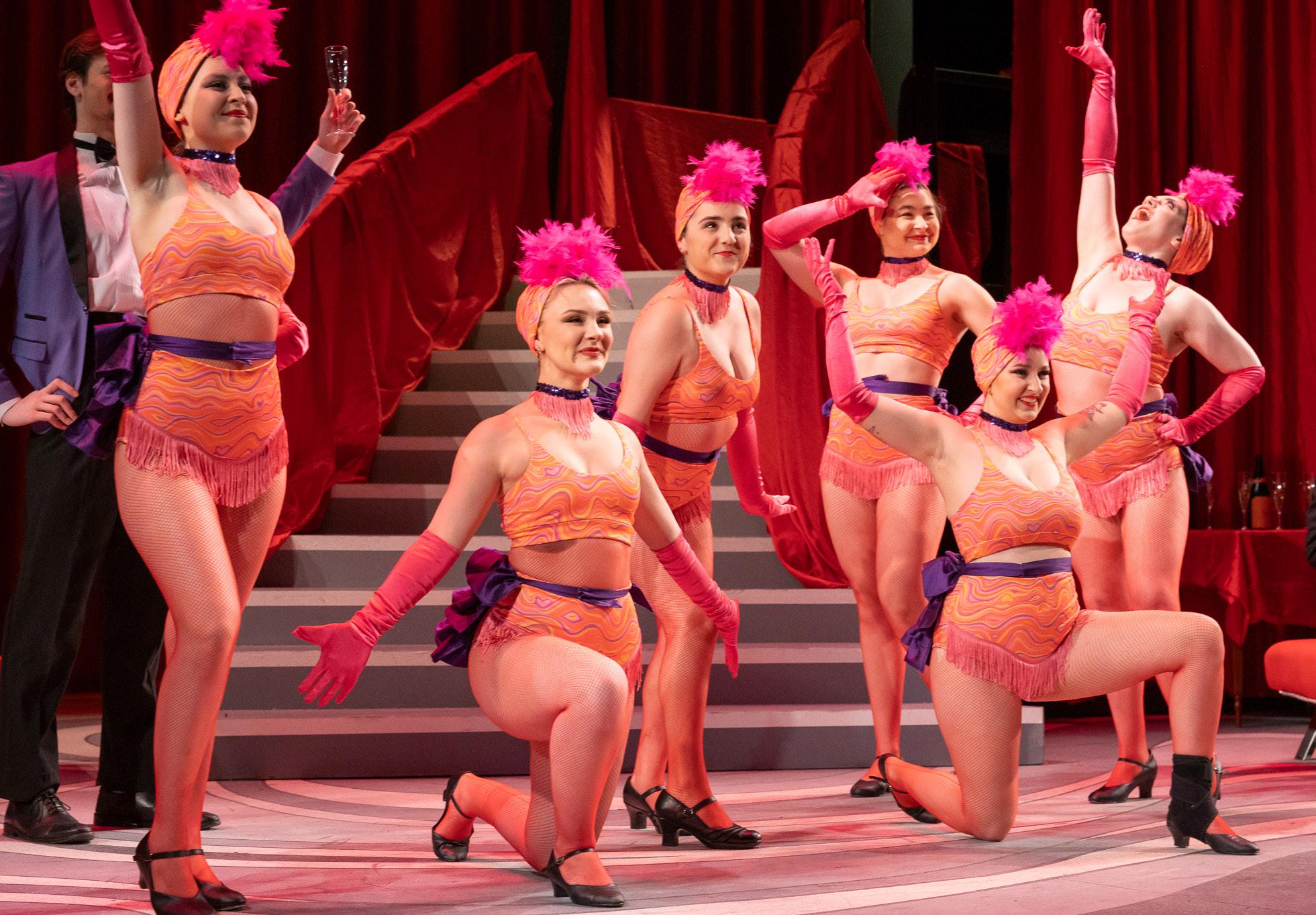
Portland State’s The Merry WidoW premiered on April 19 at Lincoln Performance Hall. The show is double-casted, with an opening night which sat a sea of attentive and excited attendees. The Merry Widow combined the traditional pageantry of classical opera with the gleefully unrestrained attitudes and melodrama of the swinging ‘60s.
The PSU student performers displayed monumental talent and passion on stage, providing an entertaining and refreshing performance overall.
Performer Serena Mason aptly described her and Megan Wakefield’s character—the titular widow, Hanna Glawari—as “stubborn yet compassionate, with a fiery spirit.”
Though the rest of the supporting cast performed wholeheartedly with thoughtfulness and sincerity, Wakefield’s Hanna Glawari was the uncontested star of the night. Fierce and charismatic, her voice generously delivered high notes which glistened as much as the jawdropping, flamingo-pink gown she wore during the first act.
“Once you have the story and everything in your body, you can just get lost in the character,” Mason said. For Mason, stage performance is all about entertaining as a collective. “It’s not about you anymore, and I think that’s what helps me. It’s about the story we’re telling, the messages that we’re trying to get across and how we present this beautiful music to this audience.”
The Merry Widow is set in Paris, France, and populated largely by ambassadors and politicians of the fictional Balkan nation of Pontevedro. The opera’s plot revolves around the efforts of Pontevedrian minister Baron Mirko Zeta—played by Izaak Thoms and Xavier Davidson—trying to keep the widowed Hanna— recently endowed with a substantial inheritance within the state—by marrying her to Count Danilo Danilovitch.
Johnny Derby embodies the role of Danilo, an affable playboy who enjoys indulging in both alcohol and scandalous flirtations. Derby
characterizes Danilo as “suave, masculine and a true romantic.”
Hanna and Danilo’s stubborn reluctance to rekindle their previous romance causes the primary conflict in the story, with the characters’ premonitions blowing hot and cold—will they or won’t they?
The subplot has to do with the Baron’s wife, Valencienne—played by March Steiger and Krista Schaeffer—and her half-hearted attempts to prevent her extramarital affair from entering the public eye. Her lover is the charming French aristocrat Camille de Rosillon—played by Noe Ramirez Perez and Jere Burkholder.
On the surface, an opera combines elements from theater, dance and musicals. Those who have never seen an opera before may assume it’s simply a few hours of heavily made-up singers belting out extremely high notes, standing center stage and illuminated by a single spotlight, but it’s much more. According to Mason, the opera is “a balancing act of trying to make sure that everything is aligned.”
“It’s a monumental effort to put one of these on,” said Dan Wallace Miller, the opera’s stage director. “The complexity is seen in the stage props and costumes and shoes and makeup. Under the shining lights, you can see the passion that each character exudes.”
Miller is based in Seattle and has worked with renowned opera houses across the country.
“I am continually astonished to be reminded that this is an undergraduate program,” Miller said about PSU’s Opera program. “This is by far the most robust opera program in the Pacific Northwest that I have worked with, and the fact that it is for undergraduate students really demonstrates this level of talent that this university attracts.”
The first note of the show instantly commands attention, reverberating through the air with shocking amplification and rich acoustics.
“When you have an opera house that’s built for the sound, to be in the theater and hear the vibration in the hall [and] the sound waves hitting you a certain way and your chair
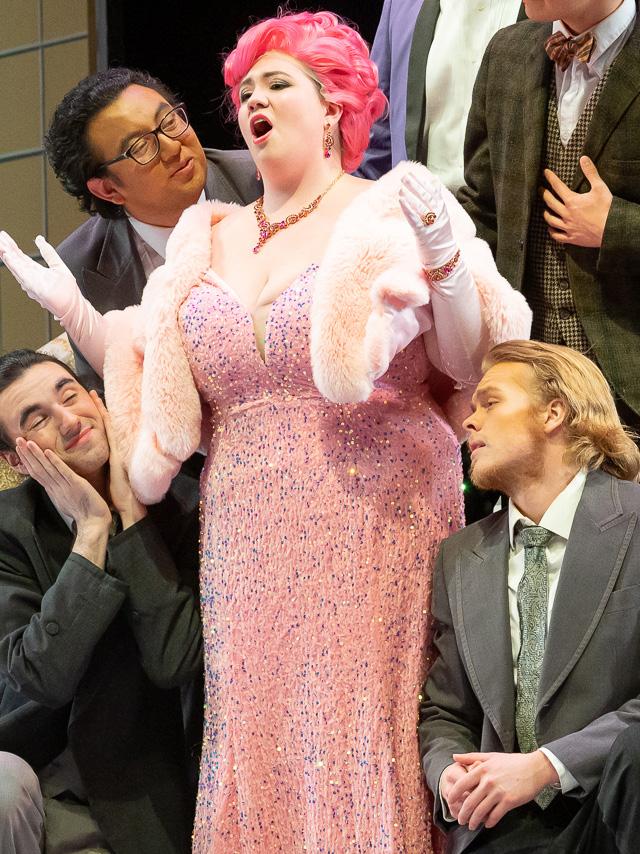
vibrating… I mean, there’s nothing like that,” said Kelley Nassief, the opera’s artistic director.
“You can’t get that from TV.”
“It’s such an experience to be in the theater and feel the energy,” Mason said. “It’s just different.” Indeed, the energy within the theater is palpable. Perhaps it’s because seeing an opera is an impermanent and uniquely communal experience.
“Opera is fundamentally about live performance,” Miller said. “There is something that is really beautiful about a live performance in that it only exists for the people watching it at that time. It coalesces from nothing and goes back into nothing.” The cast has one shot to make it right, and when you’re on stage there really is no hiding.
Dealing with the pressure of such a performance is no easy task. “You have to be a lot more prepared than you think you are,” Derby said. “When you get nervous, you won’t be taking as deep of breaths. You might get a little tired or restricted in your voice. The more prepared I am… the more I can just focus on the character and have fun.”
Though set in the 1960s, The Merry Widow still calls back to the heavily-perfumed operettas of the Edwardian era, with common tropes and archetypal personalities of the golden age of Viennese or Parisian theater. There are swooning pairs of young lovers, conflicts surrounding the conservation of wealth and the kind of gossip which only echoes through the walls of those who live in ivory towers.
However, The Merry Widow still manages to sneak in relevant and shrewd cultural and political ideas into the music, without coming off as didactic or overly intentional. The finished play finds moments where characters break the fourth wall, others where sarcasm is expressed in the rhythmic beauty of song.
There are some particularly stand-out numbers—one cleverly and hilariously dismantles masculine bravado, and another includes a titillating chorus of cabaret showgirls dancing like Rockettes.
“I made the decision to set it specifically after the point where women would have achieved suffrage, so after the 1940s, but before the

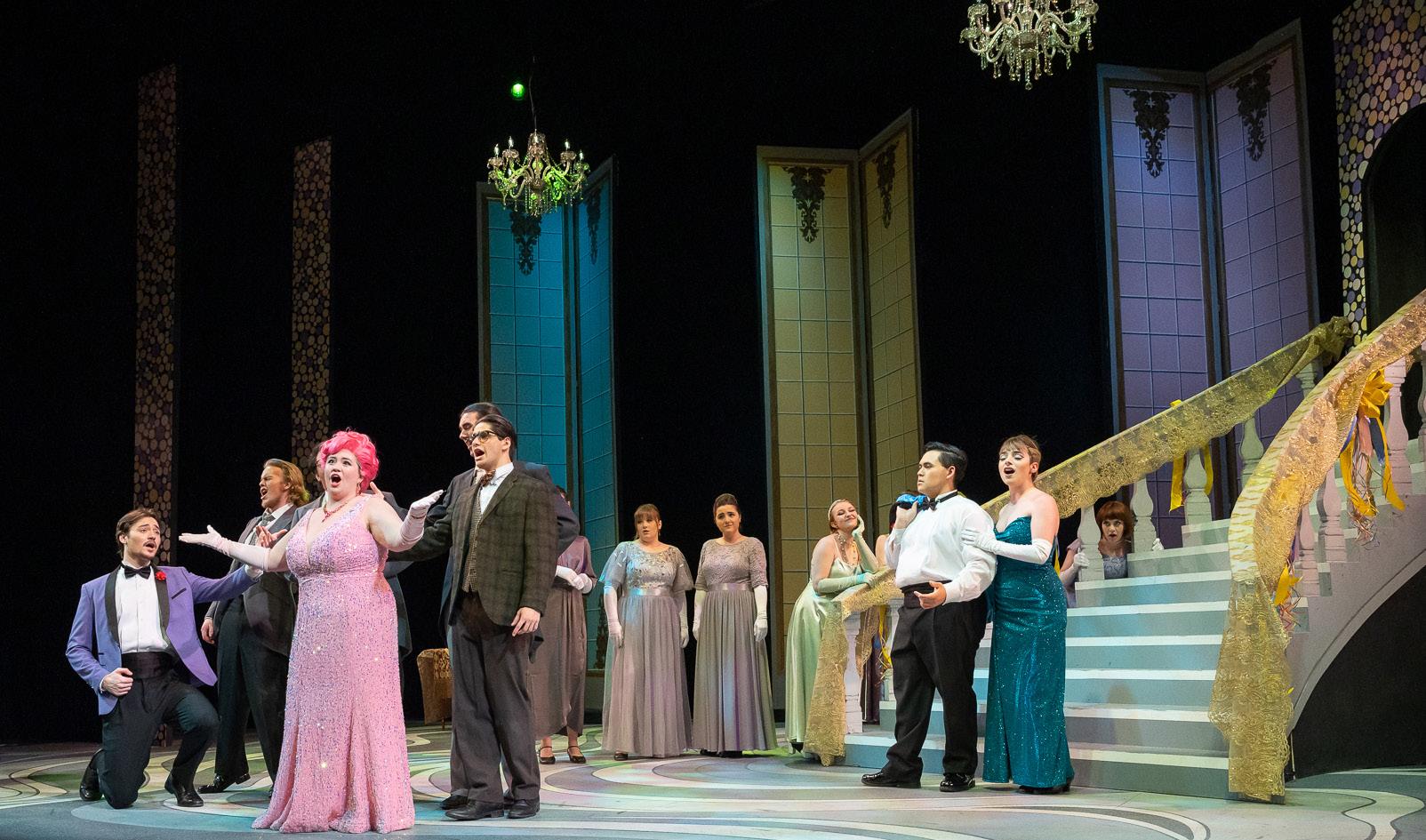
point when they had financial autonomy, which happened in 1965,” Miller said. “Setting it after a world war, a global conflict and right on the cusp of this huge social movement puts this narrative in a fresher perspective... Also, it gives us a lot of excuses to do a lot of insanely crazy stuff with the sets and the costumes.”
After the first act, the performers come out sporting a delightful costuming coup—gone are the gaudy ball gowns and on with the Jackie Kennedy-esque, short, A-line dresses and matching hats.
In the third act, the audience is pleasantly surprised and amused by another set and costume change: showgirls scantily clad, superfluous men too familiar with cheeky sexual innuendos and the classic good-girl-gone-bad vivaciously showcased by Steiger.
“Opera can have a connotation now of having a really fixed aesthetic,” Miller said. “Big dresses, chandeliers… It has a tendency and a danger of becoming a little bit stodgy or formulaic. In particular, The Merry Widow is about a lot of things that no longer correlate with society today.”
“This is an opera about an Eastern bloc nation facing utter destitution, which is a bummer of a concept, but when you dredge it in champagne and booze, somehow, you get to forget those sorts of things,” Miller said.
A major inspiration behind Miller’s vision for The Merry Widow was the French movie director Jacques Demy, particularly Demy’s film The Young Girls of Rochefort . “There’s an aspect of Demy’s films—the concern about world-rendering events is assuaged with excessive amounts of aesthetic beauty,” Miller said.
And yes, this opera is aesthetically beautiful— though, this also speaks to the inherent satire of opera itself. “It creates a world in which we shouldn’t think about global conflict and a lot of horrible things happening, because everyone is so distracted by trying to appear glamorous,” Miller said.
While the production takes a new approach to classical themes, opera itself remains somewhat removed and inaccessible for many people— particularly younger generations. “The level of cultural evaluation of an art form like opera
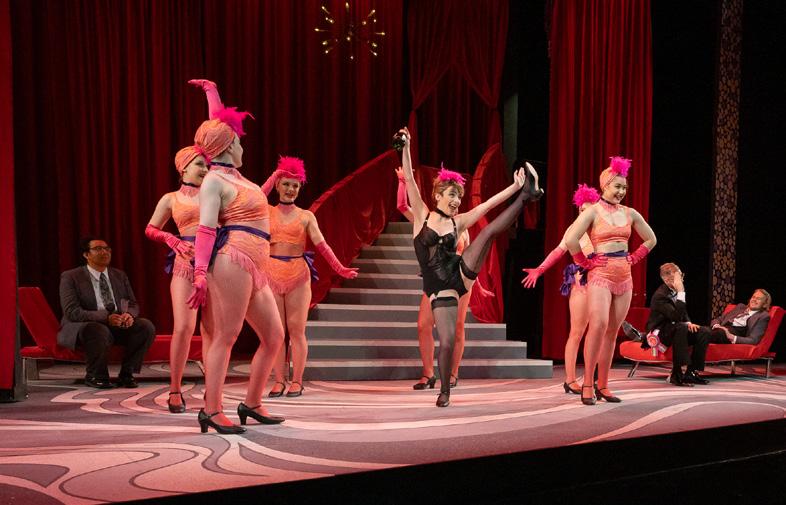


is on the decline in the United States,” Miller said. “It is something that is lacking from our early educational systems.”
If U.S. society’s esteem for performance art is, in fact, dying, “it is a cultural community issue,” Miller said. “Our civic arts—like opera houses, which exist as part of a city’s identity and infrastructure—need to be supported by educational efforts and by granting access to folks who might not have it.”
“I think opera was more familiar to people 35 years ago,” Nassief said. “People seek entertainment in a different way now than they did [in the past]. When I was younger, we didn’t have computers or cellphones, so going to see a show was more familiar to people.”
“There’s a patience factor,” Nassief said. “People like things to happen very quickly, and you have to sit in a theater and watch a show, but the reward when you do go experience a performance is so great once you’re there… Emotions haven’t changed very much, it’s just a different way of storytelling that I don’t think a lot of young people have exposure to.”
For Miller, this simple act of exposure to an
opera production could open the door to an unknown passion. “I’m a firm believer that if you get a kid in a seat to watch a show, at the very least, that they probably won’t hate it,” Miller said. In fact, Miller noted that “the most effusive audiences of all my productions everywhere I go is always from the student audience.”
PSU’s production of The Merry Widow seeks to make opera approachable and engaging for opera fanatics and those who have never seen a live performance. “It just felt so fresh and new,” Nassief said. “The storytelling initially felt like it could be a little more accessible to younger audiences, so that was something that really lit me up when we were talking about the concept.”
A passionate love of music and a fascination with the stage certainly courses throughout PSU’s opera department. Simon and Garfunkel once sang the words—quite relevantly—“Is the theater really dead?” Going to see an opera such as The Merry Widow will answer that question. And the answer is seen most clearly in the audience’s response: an ardent standing ovation and a long-lasting smile on every face.
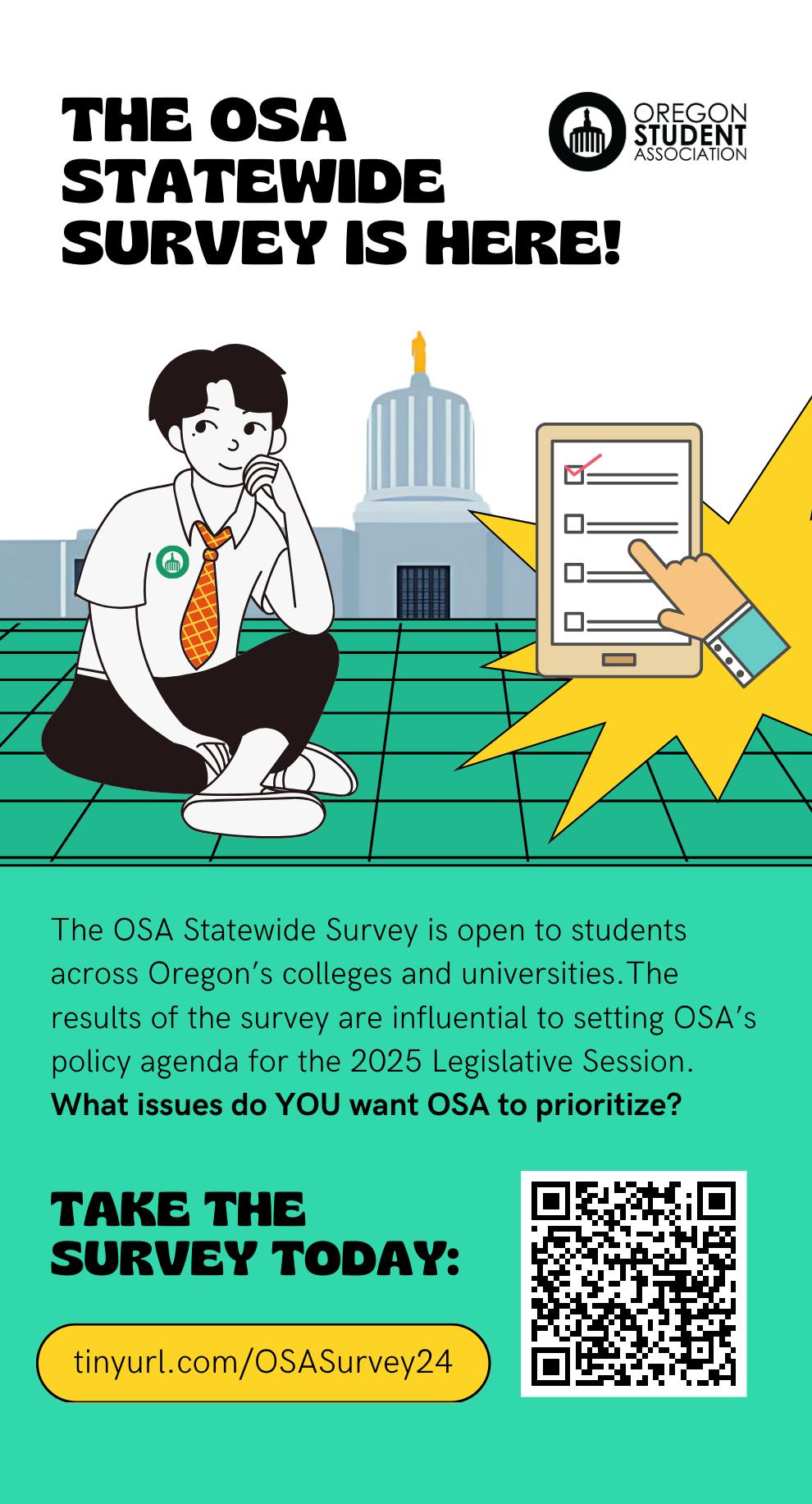

Answers for 4/29
1) Alphecca, 2) BBL, 3) PCUN, 4) nova, 5) Ozempic, 6) heat, 7) wage, 8) Summit
1. The Portland Farmers market it located in the _____ Park
4. Chinese garden in Northwest Portland known for its tranquility and unique botanical diversity
7. ASPSU president and vice president are responsible for managing the _____, two words
9. In May, PSU will hold a debate with Cudd representing academic _____
12. Lake at Lan Su Chinese Garden, a focal point for peaceful observation
2. River reachable via Columbia Area Transit, near scenic natural sites
3. This aquatic animal was mentioned as an invasive species in Oregon
5. Number of students who were shot by the Ohio National Guard during an anti-war protest in the ‘70s
6. An Indian dish which is a type of rich and flavorful fish fry
8. The Himalayan _____ is a type of plant noted for its invasive nature across the West Coast
10. This instrument can be heard during the Portland Farmers Market
11. Menstrual effluent consists of discarded cells and tissue from this, two words
13. Last name of a Pontevedrian minister aiming to arrange a marriage
14. Name of Oregon's tallest waterfall, located near Portland
15. A deep, rock-filled feature the author almost plunged into during a hike
16. An Indian snack known for its crispy textures
PSU VSA Food Drive
SMSU 327
May 6, 12 p.m.
Free for Students
A food drive collaboration for positive aging, collecting non-perishable and canned foods
Live @ Lunch
SMSU 101
May 7, 12 p.m.
Free for Students
Lunchtime live concert series where you can study and meet with local musicians
The Innocents
Lincoln Recital Hall
May 8, 7:30 p.m.
Free for Students
A social justice performance, deep diving into wrongful imprisonment
PSU Steinway Piano Series
Lincoln Recital Hall
May 10, 7 p.m.
$25
Exciting, masterful piano performances, featuring solo works and collaborations
Mr. Burns
Lincoln Hall Studio Theater
May 10, 7 p.m.
Free
A dark comedy exploring pop culture’s evolution into mythology
Trenque Lauquen
5th Avenue Cinema
May 12, 3 p.m.
Free
A biologist’s vanishment reveals life’s interwoven complexities and unanticipated connections in Argentina
PSU Basic Needs Hub
SMSU Suite 435
Mon–Fri, 9 a.m.–5 p.m.
Free for students
Helps students access resources such as funds, food, housing, employment, childcare and health support
PSU Food Pantry
1704 SW Broadway (temporary location)
Tues–Thur, 12–4 p.m.
Free for students
Access to free groceries in a welcoming, equitable, trauma-informed way. Must be enrolled in at least one credit for summer or fall
SMART recovery meetings
University Center Building 340 E Times vary
Free
In peer recovery, students with shared experiences connect to reduce stigma and build a campus recovery community
SHAC weekly online parent support group
Online
Thursdays 11 a.m.
Free
Come together as parents in a relaxed setting to support each other, share ideas, collaborate and commiserate
Women’s Resource Center Online
Mon–Fri, 9 a.m. to 5 p.m. Free
Confidential advocacy services to students who have experienced sexual harassment, assault, violence and stalking
Oregon Energy Fund
Varying Locations
Mon–Fri, hours vary Free
Provides energy bill assistance to low-income Oregonians to support household stability
SHAC Mind Spa
UCB Suite 310
Mon–Fri (by appointment) Free for students
Solo space to experience biofeedback, light therapy, meditation, massages, relaxation and more. Must be enrolled in at least five credits for summer or fall
SHAC, Suite 340E
Mon 10–12 p.m. & Fri 2–3 p.m.
Free for students
Pick up free opioid overdose reversal medication and get a 10-minute training on how to use it
Listen on Spotify
Available 24/7
Free
PSU-produced podcast about being mindful while outside, practicing gratitude, finding joy and being in the moment
SHAC Emergency and Crisis Resources
Online
Availability varies depending on resource
Free
Connecting students with free, confidential mental health and wellbeing support
Outdoor Workshop Wednesdays
Watch on Youtube
Available 24/7
Free
PSU Campus Recreation Center staff videos about topics ranging from Leave No Trace and plant identification to hiking spots and land acknowledgments
BORP online fitness studio
Watch on Zoom
Mon–Sat, hours vary Free
Bay Area Outreach and Recreation Program’s (BORP) virtual exercise classes for people with physical disabilities
